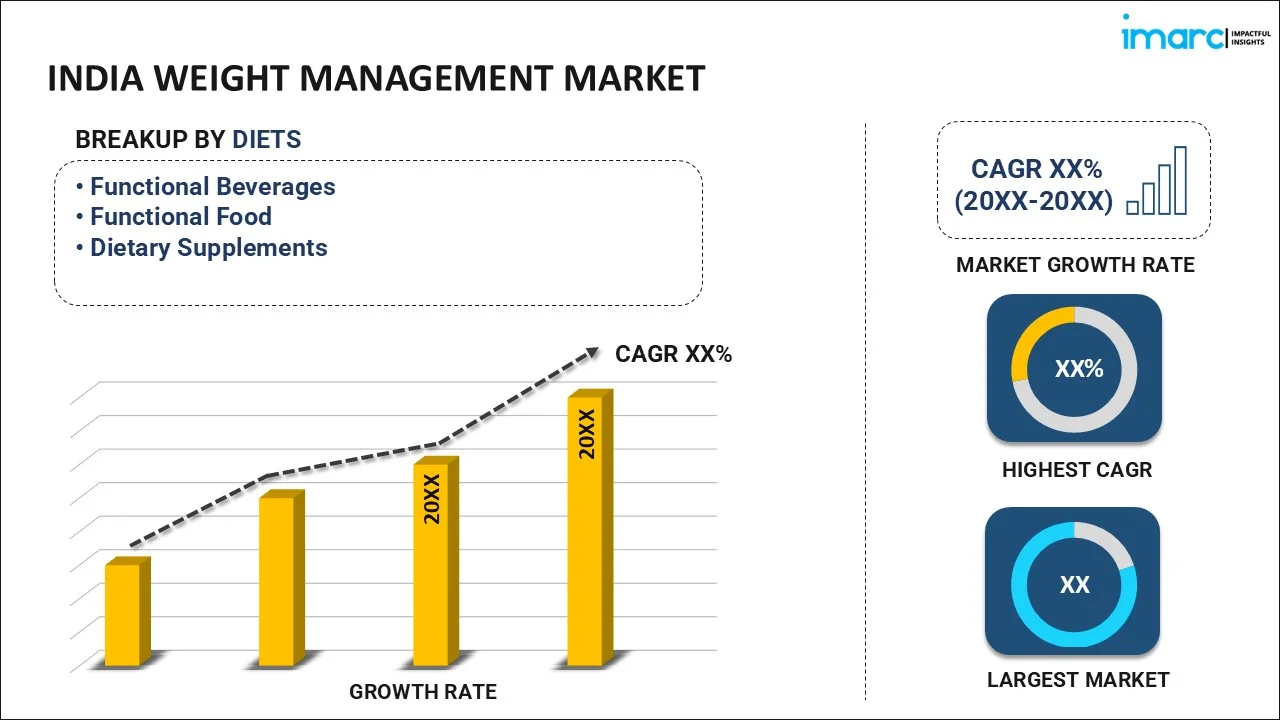
India Weight Management Market Report by Diet (Functional Beverages, Functional Food, Dietary Supplements), Equipment (Fitness, Surgical), Service (Health Clubs, Consultation Services, Online Weight Loss Services), and Region 2025-2033
Market Overview:
The India weight management market size reached USD 25.2 Billion in 2024. Looking forward, IMARC Group expects the market to reach USD 55.9 Billion by 2033, exhibiting a growth rate (CAGR) of 8.79% during 2025-2033.
|
Report Attribute
|
Key Statistics
|
|---|---|
|
Base Year
|
2024
|
|
Forecast Years
|
2025-2033
|
|
Historical Years
|
2019-2024
|
|
Market Size in 2024
|
USD 25.2 Billion |
|
Market Forecast in 2033
|
USD 55.9 Billion |
| Market Growth Rate (2025-2033) | 8.79% |
Weight management refers to the process of adopting healthy dietary and lifestyle changes to maintain healthy body weight. It helps promote healthy eating habits and incorporate daily physical activities according to the height, gender and age of the individual. It also assists in gaining the best weight possible, depending on the body mass index (BMI). At present, there is a considerable increase in the uptake of weight management services on account of rising obesity rates in India.
The increasing influence of social media, especially on the young population, represents one of the key factors supporting the growth of the market in India. Apart from this, hectic lifestyles, inflating income levels and rising consumption of fast food has escalated various weight-related health issues. This, in turn, is increasing the adoption of weight management programs and techniques in the country. Furthermore, leading players are investing in research and development (R&D) activities to introduce innovative weight-management products. Besides this, the rising number of coronavirus disease (COVID-19) cases has resulted in increasing awareness among individuals about remaining healthy and boosting their immune system. This is anticipated to fuel the market growth in the coming years.
Key Market Segmentation:
IMARC Group provides an analysis of the key trends in each sub-segment of the India weight management market report, along with forecasts at the country and regional level from 2025-2033. Our report has categorized the market based on diet, equipment, and service.
Breakup by Diet:

- Functional Beverages
- Functional Food
- Dietary Supplements
Breakup by Equipment:
- Fitness
- Surgical
Breakup by Service:
- Health Clubs
- Consultation Services
- Online Weight Loss Services
Breakup by Region:
- North India
- West and Central India
- South India
- East India
Competitive Landscape:
The competitive landscape of the industry has also been examined along with the profiles of the key players.
Report Coverage:
| Report Features | Details |
|---|---|
| Base Year of the Analysis | 2024 |
| Historical Period | 2019-2024 |
| Forecast Period | 2025-2033 |
| Units | Billion USD |
| Segment Coverage | Diet, Equipment, Service, Region |
| Region Covered | North India, West and Central India, South India, East India |
| Customization Scope | 10% Free Customization |
| Post-Sale Analyst Support | 10-12 Weeks |
| Delivery Format | PDF and Excel through Email (We can also provide the editable version of the report in PPT/Word format on special request) |
Key Questions Answered in This Report
The India weight management market was valued at USD 25.2 Billion in 2024.
We expect the India weight management market to exhibit a CAGR of 8.79% during 2025-2033.
The increasing prevalence of various weight-related issues, along with the introduction of numerous dietary supplements containing fibers that help consumers in improving their metabolism rate, is primarily the India weight management market.
The sudden outbreak of the COVID-19 pandemic has led to the growing adoption of several online-based weight management programs by individuals to boost their immunity levels at home, owing to the temporary closure of gyms and fitness centers, during the lockdown scenario across the nation.
Based on the diet, the India weight management market can be categorized into functional beverages, functional food, and dietary supplements. Among these, functional beverages currently exhibit a clear dominance in the market.
Based on the equipment, the India weight management market has been segmented into fitness and surgical. Currently, fitness equipment holds the largest market share.
Based on the service, the India weight management market can be bifurcated into health clubs, consultation services, and online weight loss services. Among these, health clubs account for the majority of the total market share.
On a regional level, the market has been classified into North India, West and Central India, South India, and East India, where North India currently dominates the India weight management market.
Need more help?
- Speak to our experienced analysts for insights on the current market scenarios.
- Include additional segments and countries to customize the report as per your requirement.
- Gain an unparalleled competitive advantage in your domain by understanding how to utilize the report and positively impacting your operations and revenue.
- For further assistance, please connect with our analysts.
 Inquire Before Buying
Inquire Before Buying
 Speak to an Analyst
Speak to an Analyst
 Request Brochure
Request Brochure
 Request Customization
Request Customization




.webp)




.webp)












